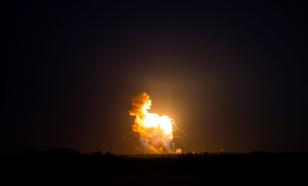The Life and Death of Russia's Space Shuttle Program
Despite of the total collapse and economic degradation that the country is experiencing, Russia is still a super-power
There are just few people who know that Lieutenant-General Vladimir Grigorkin made a considerable contribution into Russia's might. Like hundreds of people of this kind, this man spent his best years in the Siberian woods and Central Asia deserts where the nuclear shield was being created for the country.

The Energia-Buran project was the greatest one in which Vladimir Grigorkin participated. He still feels proud to speak about his participation in the project. "Now this well-known but still classified program is widely criticized. I would like to emphasize that the performance capability of the Energia-Buran project surpasses its American analogue, space shuttle. Soviet developers of the project designed it with such innovations that it would even today be considered a technological wonder.
I would also like to return an objection to those people who like to criticize the domestic defense establishment and say that Soviet experts were successfully working on laser weapons. As for this sphere, Russia is considerably ahead of the US."
With the help of the Energia rocket and the Buran orbital ship, we could have launched even military stations of different types. If we had done this, would have the Pentagon risked unleashing a war at any moment?
But when the Soviet Union collapsed, the Russian project of a space ship was abandoned. It is not clear what motivated the powers-that-be to allow one of the Buran project crafts put on public display in Moscow's Gorky Park of Culture."
Long before the Buran project, Vladimir Grigorkin participated in construction of launchig pads for different rockets. "I worked for a year in Siberia as the head of a department building silos for the world's most powerful ballistic rockets. NATO called the rockets "Satans". They could challenge the US' most modern anti-missile defense system. One rocket of this type carries up to ten self-guided high-power warheads. On board, the rocket has a considerable number of false targets to mislead the enemy. It's a pity that it was realized too late; it was important to keep the weapon in operation. The majority of rockets of the type were liquidated. even though they were still operable."
When Vladimir Grigorkin became the head of the special construction department of the Defense Ministry, the silos were being built across the Soviet Union. Now, we have such rockets in Russia only.
The general is not that anxious about the disputes concerning the so-called anti-missile defense. Some time ago, Vladimir Grigorkin participated in creation of an anti-missile shield around Moscow. He says that nowadays only 30 per cent of Russia is protected from attacks of aerospace vehicles, while in the Soviet era the missile shield covered the whole territory of the country. The general is indignant at the fact that the national defense has such large breaches that we may notice attacks of an enemy on some territories only when we see nuclear explosions over these territories.
Vladimir Grigorkin doesn't believe that NATO is peaceful: "We are told that NATO expansion toward the Russian borders won't do any harm to Russia. But unfortunately, the majority of the Russian population is ignorant of the fact that our new "friends" won't disarm. Today, the number of NATO planes is three times larger than that of Russia; where we have one tank NATO has five armored vehicles. NATO also enjoys the overwhelming advantage in human resources. In the Baltic region, NATO is busy with reconstruction of former Soviet aerodromes abandoned by our troops."
Last year, many news agencies spread sensational news: a workshop where the Buran orbital ships were kept collapsed. Vladimir Grigorkin tells details of the catastrophe: "There is a huge technical building on the Baikonur space center where rockets are being assembled. The size of the building is amazing; it is about 50 meters tall. When the roof of the building started leaking and repairing was started on it. For the sake of money saving, the authorities invited workers from Moldavia who charge less for repairing. The workers took the ruberoid off and stacked it into one spot on the roof. Finally, the slates couldn't endure the extra load and fell down upon the Buran orbital ship. It was the same ship that flew into space. Besides the space ship one more rocket got broken in the incident too.
The ruins are not yet completely cleared. This is awful that some dead bodies still remain under the debris. The clearing work was halted for an uncertain period."
Vitaly Moiseyev
Subscribe to Pravda.Ru Telegram channel, Facebook, RSS!


